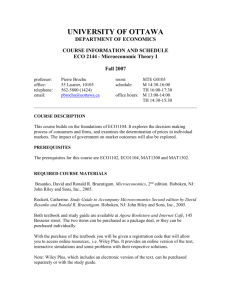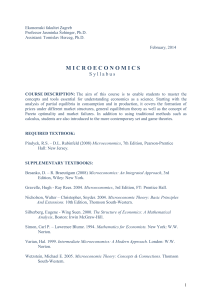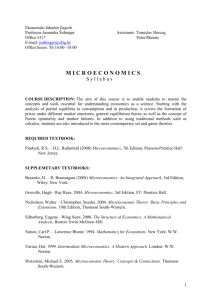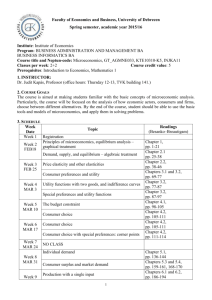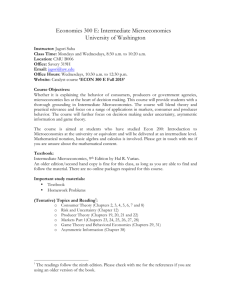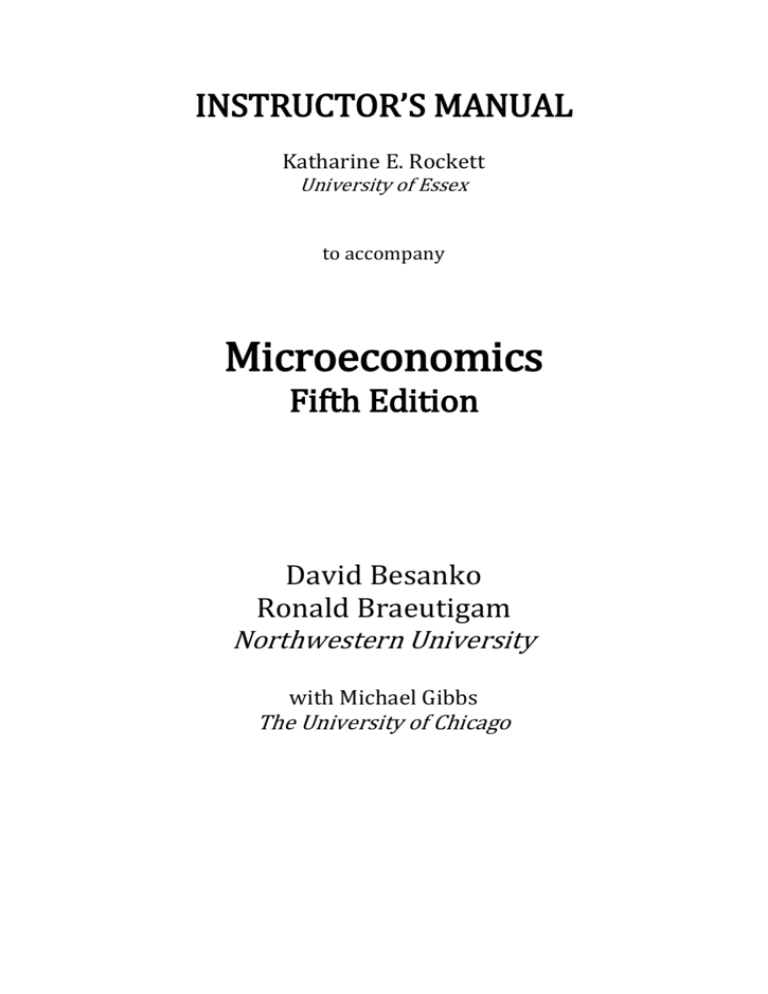
INSTRUCTOR’S MANUAL
Katharine E. Rockett
University of Essex
to accompany
Microeconomics
Fifth Edition
David Besanko
Ronald Braeutigam
Northwestern University
with Michael Gibbs
The University of Chicago
Copyright © 2014 John Wiley & Sons, Inc.
All rights reserved.
Reproduction or translation of any part of this work beyond that permitted by Sections 107 and 108 of
the 1976 United States Copyright Act without permission of the copyright owner is unlawful. Requests
for permission or further information should be addressed to the Permissions Department, John Wiley &
Sons, Inc.
Besanko & Braeutigam – Microeconomics, 5th edition
Instructor’s Manual
Contents
Preface to the Fifth Edition
Model of Course Description for Syllabus
Course Reading List
Using the Supplementary Materials
iv
iv
v
vii
Chapter Highlights
Chapter 1: Analyzing Economic Problems
Chapter 2: Demand and Supply Analysis
Chapter 3: Consumer Preferences and the Concept of Utility
Chapter 4: Consumer Choice
Chapter 5: The Theory of Demand
Chapter 6: Inputs and Production Functions
Chapter 7: Costs and Cost Minimization
Chapter 8: Cost Curves
Chapter 9: Perfectly Competitive Markets
Chapter 10: Competitive Markets: Applications
Chapter 11: Monopoly and Monopsony
Chapter 12: Capturing Surplus
Chapter 13: Market Structure and Competition
Chapter 14: Game Theory and Strategic Behavior
Chapter 15: Risk and Information
Chapter 16: General Equilibrium Theory
Chapter 17: Externalities and Public Goods
1
1
2
3
4
5
6
7
8
9
10
11
12
13
14
15
17
19
Sample Questions for Exams and Assignments
Analytical Problems
Analytical Problems: Answers
Multiple-Choice Questions
Multiple-Choice Questions: Answers
Short-Answer Questions
Short-Answer Questions: Answers
Essay Questions
Essay Questions: Answers
Modeling Questions
Modeling Questions: Answers
Copyright © 2014 John Wiley & Sons, Inc.
20
20
40
89
97
103
107
112
116
128
132
iii
Besanko & Braeutigam – Microeconomics, 5th edition
Instructor’s Manual
Preface to the Fifth Edition
Thank you for adopting Microeconomics, Fifth Edition. I hope that this manual is helpful in teaching your
intermediate microeconomics course. This manual includes sample syllabi, comments on each chapter,
and problem sets that can be used for exams and assignments.
The entire textbook can be covered in a year-long course of 20 weeks, with two fifty-minute
meetings per week and one class meeting with a teaching assistant to cover problem sets and answer
questions. The material of chapters 1-9 fits in a single-term 10-week course of the same format. The
basics of each chapter and a selected extension take about one week of lecture to cover. You can, of
course, extend this presentation to formats with more weeks. Guidance is given below, and there is
plenty of material in each chapter for more in-depth treatments. Conversely, the book is sufficiently
modular that you needn’t cover it in its entirety.
The book is conceptually challenging for intermediate level students but very accessible
mathematically. It appeals to a wide range of students, from the beginners to the advanced, and from the
"mathy" students to the "talkers". The form of evaluation you choose can be equally flexible, as indicated
with the different styles of problems in this manual. An exam that utilizes essays, multiple-choice, and
analytical questions allows students with many different learning styles to achieve. Another advantage of
the book is that the learning-by-doing approach lends itself to student participation, even in large lecture
courses. I sprinkle learning-by-doing examples and multiple-choice questions throughout my lecture
after I go through each concept and encourage students to participate in solving the problems. They
respond well to this and it makes the lectures lively.
This manual is just one of many teaching and learning resources that include the text, a Solutions
Manual, a Test Bank, Student Practice Quizzes, a Mobile Access Pack, and other lecture materials (such as
PowerPoint slides and an Image Gallery). These materials should be used together to achieve maximum
effect. Comments on how this can be done are included throughout this manual.
While I have made every effort not to duplicate problems from the Instructor’s Manual
elsewhere, it is a good idea to check that they do not appear in any of the other supplements before using
these problems for an exam or assignment.
Of course, any comments or suggestions that you have on the text or the supplemental materials
would be gratefully received. I hope that you enjoy teaching from this material.
Model of Course Description for Syllabus
Economics is the social science that deals with the allocation of limited resources to satisfy unlimited
human wants. Broadly speaking, economics is composed of two branches: microeconomics and
macroeconomics. Microeconomics studies the economic behavior of individual economic decisionmakers, such as consumers, workers, firms, or managers. It also analyzes the interaction and behavior of
groups of these individuals, such as households, industries, markets, labor unions, and trade associations.
This framework is absolutely fundamental to understanding an enormous range of phenomena in
business, public policy, social behavior, and a variety of other fields.
We will begin with an overview of the equilibrium behavior of competitive markets. The main
tools that economists use to analyze the behavior of such markets are the demand curve, the supply
curve, and the notion of market equilibrium, which characterizes the interaction of the forces of demand
and supply. We will then spend the rest of the term going beyond our overview to understand how
market demand curves and market supply curves come about. We will do this by building up a model of
consumer preferences and consumer choice, which can be used to derive a market demand curve. Next,
we build up a model of the theory of production and firm behavior to derive a market supply curve. At
the end of the term, we will return to the concept of market equilibrium with our more detailed
understanding of demand and supply in order to derive further properties of market behavior and
conduct policy analysis.
Copyright © 2014 John Wiley & Sons, Inc.
iv
Besanko & Braeutigam – Microeconomics, 5th edition
Instructor’s Manual
The type of analysis we conduct in the first term is called partial equilibrium because it
characterizes behavior in a single market. We will spend the first week of the second term analyzing
equilibrium when many markets exist and interact. This is called general equilibrium analysis. We will
also derive some welfare properties of competitive markets for both partial and general equilibrium.
Next, we move beyond competitive industry structures to consider various other commonly-observed
industry structures such as monopoly and oligopoly. We will observe how industry equilibrium differs
from the competitive case for each of these structures. After this, we introduce uncertainty into our
analysis of equilibrium. We conclude the term with a discussion of externalities and public goods. As a
whole, the approach of the second term is more topical than that of the first term.
Microeconomic analysis relies on a small set of enormously powerful analytical tools:
constrained optimization analysis, equilibrium analysis, and comparative statics analysis. This course
attempts to help you master these tools by presenting their graphical, algebraic, and logical mechanics, as
well as by illustrating their use in many different contexts.
Course Reading List
Each chapter takes approximately one week to cover thoroughly. I allocate the following amount of time,
where each "session" represents one fifty-minute lecture (generally two lectures per week). I
supplement each week's material with a class meeting with a teaching assistant to review problem sets.
Chapter 1: Analyzing Economic Problems
Chapter 2: Demand and Supply Analysis
Chapter 3: Consumer Preferences and the Concept of Utility
Chapter 4: Consumer Choice
Chapter 5: The Theory of Demand
Chapter 6: Inputs and Production Functions
Chapter 7: Costs and Cost Minimization
Chapter 8: Cost Curves
Chapter 9: Perfectly Competitive Markets
Chapter 10: Competitive Markets: Applications
Chapter 11: Monopoly and Monopsony
Chapter 12: Capturing Surplus
Chapter 13: Market Structure and Competition
Chapter 14: Game Theory and Strategic Behavior
Chapter 15: Risk and Information
Chapter 16: General Equilibrium Theory
Chapter 17: Externalities and Public Goods
1-1/2 sessions
2-1/2 sessions
2 sessions
2 sessions
3 sessions
1-1/2 sessions
1-1/2 sessions
2 sessions
3 sessions
1-1/2 sessions
2 sessions
2 sessions
4 sessions
2 sessions
2 sessions
3 sessions
2 sessions
Schedule one session each term for a mid-term test and a review session.
Based on this schedule, you can expect to be able to design the following types of courses:
1.
20-week course: All the chapters can be covered. Schedule one midterm exam after Chapter 5 and a
review session after Chapter 9. Schedule one midterm exam after Chapter 14 in the second term and
a review session after Chapter 17. NOTE: I suggest moving Chapter 16 to the beginning of the second
term.
For courses with two midterms per term, schedule the midterms following Chapters 5, 8, 12, and 14.
2.
10-week course: A standard microeconomics one-term course would cover the first 9 chapters over
10 weeks, with a midterm exam after Chapter 5 and a review session after Chapter 9. You may wish
to assign section 10.1 of Chapter 10 to cover the invisible hand results. This may be added easily to
the material in Chapter 9 and is covered relatively quickly. Notice that general equilibrium is not
included in this syllabus.
Copyright © 2014 John Wiley & Sons, Inc.
v
Besanko & Braeutigam – Microeconomics, 5th edition
Instructor’s Manual
If you wish to schedule two midterms, do so after Chapters 5 and 8.
3.
4.
15-week course: Cover the first 9 chapters over 9-1/2 weeks. Cover Chapter 10.1 at the end of
Chapter 9's material. After this, the remaining course can be designed in several ways:
a.
For an emphasis on market structure, include chapters 11-14. Schedule midterms after Chapters
5 and 11. (Note: I have left time for review lectures.)
b.
For an emphasis on regulation, follow the first 9 chapters and 10.1 with the rest of 10, 11, 12, 15
and 17. Schedule midterms after Chapters 5 and 12.
c.
For an emphasis on general public policy and welfare, follow the first 9 chapters with Chapters
10, 11, 12, 16, and 17. This will probably leave you a bit short on time, so cut out all except the
first-degree price discrimination portion of Chapter 12 (i.e., assign only Chapter sections 12.1
and 12.2). Schedule midterms after Chapters 5 and 12.
d.
A variant of option (a) would emphasize antitrust analysis. This would include the same
schedule as (a) but would orient the discussion towards competition law rather than strategic
interactions.
This text can be used in business courses. You may wish to de-emphasize the theory of demand in
such a course in order to be able to spend more time on market structure. I would recommend
condensing the presentation of this material by covering only the following sections of Chapters 4
and 5: 4.1, 4.2, 5.1, 5.3, and 5.4. If your course emphasizes compensation issues, cover section 5.5
quickly. This should mean that you can cover the demand side in a total of 5 sessions (2-1/2 weeks).
This should leave you time, in a 15-week course, for Chapter 10.1, 11, 12, 13, and 14. Schedule
midterms after Chapters 7 and 11.
Copyright © 2014 John Wiley & Sons, Inc.
vi
Besanko & Braeutigam – Microeconomics, 5th edition
Instructor’s Manual
Using the Supplementary Materials
Students need a lot of practice to learn this material. The end-of-chapter problems can be used for
marked assignments, as the answers are contained in a separate Solutions Manual. I have found the endof-chapter problems to be very good tools for learning the material, but they are a bit easier than the level
of exam I like to give. As a result, while I generally assign end-of-chapter problems for the weekly review
classes with the graduate student assistants, I give at least two "self-tests" during each term. These selftests are composed of problems equal in difficulty to those on my exams and are good preparation for my
final exam. At the end of this manual, you will find a large selection of problems in various formats that
can be used for self-tests. Two to three of these problems should be sufficient for a 60-minute, closedbook, closed-notes self-test. Have the graduate assistants go over the self-tests in the weekly review
classes. The self-tests are not intended to be marked; they are a feedback mechanism for students to
gauge their progress.
The Student Practice Quizzes include interactive problem sets for students to solve and obtain
feedback on their efforts. The difficulty level is slightly lower than that of the additional problems in the
Mobile Access Pack. The "exercises" in the text of the Mobile Access Pack and the Student Practice
Quizzes can be considered to be equally difficult. PowerPoint presentations are available for each
chapter's lecture. The Image Gallery, a set of enlarged graphs, charts, and illustrations from the text in
PowerPoint format, is also available.
For exam preparation, you can use the questions at the end of this manual, or you can use
problems from the Test Bank. This bank contains multiple choice questions as well as word (analytical)
problems of varying levels of difficulty. The Test Bank is somewhat easier than the practice exams in the
Mobile Access Pack and is of equal difficulty to the Student Practice Quizzes. There is some minor overlap
between the Student Practice Quizzes and theTest Bank, but this should amount to no more than three or
four problems per chapter. A Computerized Test Bank allows you to customize your quizzes and tests for
students.
All the above material can be found at www.wiley.com/college/besanko.
Copyright © 2014 John Wiley & Sons, Inc.
vii
Besanko & Braeutigam – Microeconomics, 5th edition
Copyright © 2014 John Wiley & Sons, Inc.
Instructor’s Manual
viii
Besanko & Braeutigam – Microeconomics, 5th edition
Instructor’s Manual
Chapter Highlights
Chapter 1: Analyzing Economic Problems
This chapter introduces three basic tools needed to analyze microeconomic problems: constrained
optimization, equilibrium analysis, and comparative statics. These concepts are introduced on a very general
level with some simple illustrations. All details are left to later chapters; however the text refers back
frequently to the general tool being used. Indeed, students might wish to re-read this chapter at the end of
the course to re-unify the material.
Some highlights include:
Nature of Microeconomic Analysis
Constrained Maximization: Objective Functions and Constraints
Exogenous and Endogenous Variables
Marginal Reasoning
The Concept of Equilibrium
Comparative Statics
Positive and Normative Analysis Compared
This chapter sets the stage for the first part of the course (chapters 3 - 9) and draws together this
material into a single “toolbox”. The main ideas are reviewed quite early in the text. Equilibrium and
comparative statics is revisited in Chapter 2. Constrained optimization plays a major role in chapter 4. Some
of the basic ideas of this chapter can be reviewed when you cover game theory (chapter 14) by comparing
game theoretic models, equilibria, and reasoning to the constrained optimization models of chapters 3 - 9.
Students enjoy the example about advertising expenditures (table 1.1). It can be used as a basis for
discussion during lecture so that students can guess what the optimum would be. Usually someone gets it
wrong and someone else gets it right, so it is “rewarding” as a discussion because it can be used to illustrate
the value of economic analysis, but also is not too discouraging.
I have included a problem (number 55) in the Analytical Problems section of this manual that
expands on the cap and trade (“climate change”) example at the opening of the chapter. Notice that the
framework of “cap and trade” is very similar to Application 1.2 (“The Toughest Ticket in Sports”). This
problem can be extended into quite a long discussion if you include all the parts at the end. Ensuring that
students can solve this problem, understand how to set up and manipulate the graph, interpret equilibrium
and comparative statics using the graph, and understand the implications of cap and trade for emissions
control is usually enough for the first class with a graduate teaching assistant.
Copyright © 2014 John Wiley & Sons, Inc.
9
Besanko & Braeutigam – Microeconomics, 5th edition
Instructor’s Manual
Chapter 2: Demand and Supply Analysis
Chapter 2 develops building blocks that help answer questions about the equilibrium behavior of competitive
markets. These building blocks are the demand curve, the supply curve, and the notion of market
equilibrium. The chapter also introduces the concept of elasticity, which helps to describe the shape of
demand and supply curves. The chapter presents several "back of the envelope" methods that allow demand
and supply curves to be obtained for specific markets based on a minimum of information.
Some highlights include:
The Market Demand Curve
The Market Supply Curve
Market Equilibrium
Excess Supply and Demand
Comparative Statics Analysis applied to Supply and Demand
Elasticities
Back–of-the-Envelope Calculations
The first half of this chapter will be familiar to students from their Principles course. This material
provides a review of the general tools of equilibrium analysis and comparative statics from Chapter 1 in a
familiar context so that their more general nature can be emphasized without too much distraction. This is
excellent to develop students’ ability to see the general mathematical methodology that underlies demand
and supply graphs.
The chapter then moves on to the difficult concept of elasticity, ranging from the calculation of
elasticity to how it can be used. Students have enormous difficulty with both. Consider assigning extra
problems on this or devoting an extra class session to it. The first three multiple choice questions in this
manual go over price elasticity of demand, but do give extra practice from the end of chapter problems or the
supplementary materials. You may also wish to ask students to write an essay as part of their problem set on
why we use elasticities rather than slopes of demand curves to describe sensitivity of quantity to price.
Without getting the answer to this question straight, students often have a hard time figuring out why they
are bothering with elasticities in the first place.
Students particularly enjoy the "Back-of-the-Envelope" segment, as it allows them to apply the
material. Indeed, this chapter spends a lot of time showing students not just the calculations but how they
can be used to get answers to the sort of questions real businesses and policy makers would pose.
An interesting link between the students' econometrics course and this course can be made using the
first “modeling question” in the Sample Questions for Exams and Assignments section. This problem can be
used either to illustrate "back-of-the-envelope" techniques or can be used as a start for an econometric
analysis. It would be interesting for students to see this same problem presented both in their
Microeconomics course and in their Econometrics course to examine the linkages in the approaches.
Many of the problems in the Mobile Access Pack and this manual cover material that is presented in
more detail in Chapter 10 (government intervention and its effect on the market). You can recall these
problems when you go over Chapter 10. This may make Chapter 10's material seem more accessible to
students. You can also use this chapter’s problems (either here or in the Mobile Access Pack) to anticipate
Chapter 9's material on the slopes of long-run and short-run supply functions.
Copyright © 2014 John Wiley & Sons, Inc.
10
Besanko & Braeutigam – Microeconomics, 5th edition
Copyright © 2014 John Wiley & Sons, Inc.
Instructor’s Manual
11

